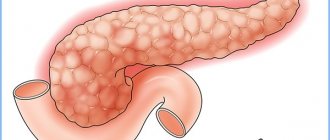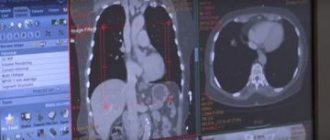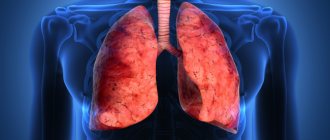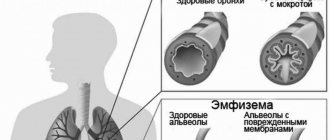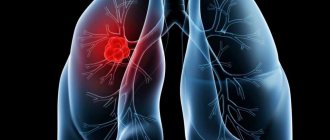Pneumonia (officially pneumonia) is an inflammatory process in one or both respiratory organs, which is usually of an infectious nature and is caused by various viruses, bacteria and fungi. In ancient times, this disease was considered one of the most dangerous, and although modern treatments make it possible to get rid of the infection quickly and without consequences, the disease has not lost its relevance. According to official data, in our country every year about a million people suffer from pneumonia in one form or another.
- Description of the disease
- Varieties
- Causes
- Symptoms
- Croupous inflammation
- Atypical inflammation
- Chronic inflammation
- Symptoms in adults
- Symptoms in children
How dangerous is pneumonia without fever?
Pneumonia (symptoms in adults without fever occur with uncontrolled use of antibiotics against the common cold) is very dangerous and often leads to death, especially in weakened and elderly people.
The latent form of pneumonia is dangerous not only due to complications, but also due to prolongation of the disease, which may go unnoticed. The absence of temperature is a sign that the inflammation has spread to neighboring tissues.
Pneumonia, in which the temperature does not rise, is fraught with the following dangers:
- Difficulty of diagnosis – pneumonia without fever cannot be detected with a stethoscope and requires additional tests;
- the disease is mistaken for a common cold or ignored for a long time, which is fraught with prolongation of the disease and complications;
- absence of fever is a sign of weakened immunity, so the disease is especially severe;
- If there is no temperature with pneumonia, it means that the inflammation has spread throughout the body. Therefore, dangerous complications may occur;
- taking antibiotics, anti-inflammatory and antitussive drugs does not relieve inflammation and is fraught with heart complications;
- when the disease drags on in old age, the risk of heart complications, heart attacks, strokes and even death increases.
Classification
- Community-acquired pneumonia is the most common type of disease.
- Nosocomial or hospital-acquired pneumonia. This form includes a disease that developed while the patient was in the hospital for more than 72 hours.
- Atypical pneumonia. A type of disease caused by atypical microflora (chlamydia, mycoplasma, legionella, etc.).
- Aspiration pneumonia is an infectious-toxic damage to the pulmonary parenchyma that develops as a result of the contents of the oral cavity, nasopharynx, and stomach entering the lower respiratory tract.
Depending on the etiology, pneumonia can be:
- viral;
- fungal;
- bacterial;
- mycoplasma;
- mixed.
Depending on the nature of the disease:
- acute;
- acute protracted;
- chronic;
- atypical.
Type of pneumonia by location
- left-handed;
- right-sided;
- unilateral: one lung is affected;
- bilateral: both lungs are affected;
Severity of the inflammatory process:
- light;
- moderate severity;
- heavy.
Classification of pneumonia
Pneumonia has several types and divisions.
According to the form of manifestation, there are acute, chronic and latent forms:
| Classification of pneumonia - type, form of course: | Characteristic |
| Acute | It begins suddenly - with a sharp rise in temperature, a characteristic cough, chest pain, and often develops against the background of diabetes, heart attack or stroke. |
| Chronic | It develops when the acute form of pneumonia is not treated correctly; it is characterized by lethargy, heavy sweating, loss of appetite, pale skin, lethargy and drowsiness. This form is dangerous due to complications and the spread of inflammation to neighboring tissues. |
| Hidden | Develops with reduced immunity and incomplete elimination of the source of inflammation. It is characterized by fatigue, increased fatigue, decreased temperature, pallor, and heavy sweating. This disease is often mistaken for general weakness of the body after a cold or flu. Without proper treatment, the disease can take dangerous forms. |
| Classification according to the severity of the disease: | Characteristic features: |
| Light form | The respiratory rate per minute is no more than 25, the symptoms are mild, and the disease resembles a common cold and does not require hospitalization. There are no signs of body poisoning. The temperature does not rise above 38 degrees. |
| Average | The respiratory rate per minute is about 30, the pressure drops, the temperature rises to 39 degrees, there are signs of intoxication, but they are mild. This form of pneumonia requires hospital treatment. |
| Heavy | Frequent breathing of 100 or more breaths per minute, temperature above 40 degrees, clouding of consciousness, severe intoxication of the body, leukocytosis and a sharp decrease in blood pressure. This form of the disease is dangerous with high mortality and requires immediate hospitalization and intensive care in a hospital setting. |
Prevention
Prevention of pneumonia
Prevention against pneumonia is, first of all, strengthening the immune system at home: good nutrition, taking multivitamin complexes in the off-season, regular walks, moderate physical activity.
In order not to provoke the development of secondary pneumonia against the background of other diseases, the following preventive measures will help:
- For persons over 65 years of age - regular vaccinations against certain types of streptococcal pathogens.
- Annual flu vaccinations for the whole family.
- During the cold season, limit physical activity and avoid hypothermia.
- During flu and ARVI epidemics, wash your hands more often with soap to remove microorganisms.
- Do not smoke - cigarettes reduce the resistance of the lungs and bronchi to colds.
- Treat chronic diseases such as sinusitis, tonsillitis and ordinary caries in a timely manner.
- Avoid contact with people with pneumonia.
Pulmonary inflammation in various forms is a very common disease among both adults and children. Everyone needs to know the main signs of this disease in order to distinguish lung damage from a cold or flu in time and begin full treatment in the hospital or at home.
Signs of the disease
Even if pneumonia occurs without fever and pronounced symptoms of a dangerous form of the disease, various signs of the disease may appear.
For example:
- weakness and constant fatigue;
- heavy sweating;
- inability to climb stairs without shortness of breath;
- fast fatiguability;
- constant thirst;
- lack of appetite or nausea;
- cold sweat;
- drowsiness;
- in some cases there is a severe cough, but without fever or other signs of a cold.
Pneumonia (symptoms in adults without fever often develop in older people) often develops against the background of influenza, colds or acute bronchitis.
At the onset of the disease, the symptoms of a cold are extinguished by antibiotics or anti-cold medications, but instead of recovery, severe weakness occurs, which is taken to be a weakening of the body after a cold.
However, as is typical for latent pneumonia, immunomodulatory drugs and bed rest do not bring relief, unlike post-influenza asthenia. If your health does not improve after a cold, tests are taken to check for latent pneumonia.
The main symptoms of pneumonia in an adult
Colds and flu should not last more than 7 days, but if 4-7 days after the onset of ARVI the patient’s condition worsens, this is a signal of the onset of dangerous inflammation in the lower respiratory tract. Symptoms of pulmonary inflammation in adults include pallor and shortness of breath. If a person has a cold, they are accompanied by weakness, sweating, and loss of appetite - this is typical for intoxication at the onset of pneumonia.
Temperature
With atypical pneumonia, the body temperature is not always above 37.5. In ordinary cases, a sharp increase to 40 degrees is typical. In case of inflammation of the respiratory tract, antipyretic drugs do not work. If you cannot bring down the temperature, this is a sign of pneumonia. The temperature begins to drop as the antibiotics take effect. It is dangerous if the disease occurs without fever: patients sometimes do not take action until the condition worsens. How long the temperature lasts depends on the pathogen: fungus, bacteria or virus.
Cough
At the beginning of the disease, the cough is dry, which is called unproductive. It becomes intrusive, constant, debilitating. As inflammation develops, this symptom also changes. Sputum comes out, the color of which depends on the nature of the infection: yellow-green, purulent, “rusty.” A persistent cough that does not go away within 7-10 days is a clear sign of an inflammatory process in the lungs.
Voice tremors
The doctor can recognize the symptoms of the disease by assessing the patient's vocal tremors. The patient says words that contain several “r” sounds, and the doctor places his palms on his chest and determines the vocal tremor. When the disease occurs, part of the lung, or the entire lung, becomes denser. This will be noticed by the physician conducting the diagnosis by the fact that the vocal tremors intensify.
Symptoms of pneumonia without fever and cough
Pneumonia without characteristic symptoms occurs with the following symptoms:
- rapid breathing;
- painful cough;
- general weakness, fatigue and lethargy;
- sweating, cold sweat even with little physical activity;
- even with mild physical activity, a strong heartbeat occurs;
- sharp pain when turning the body;
- the temperature stays around 37 degrees;
- blood pressure decreases;
- dizziness;
- cough does not go away after a cold;
- while breathing, there is a feeling that the chest is rising unevenly;
- pallor, change in complexion;
- increased heart rate even with habitual physical activity;
- red spots on the face, characteristic of inflammation;
- cough for more than 2 weeks;
- chest pain;
- spasms in the chest.
conclusions
- Pneumonia is an inflammation of the lungs, often a complication of other diseases, threatening respiratory failure, sepsis, and can be fatal.
- Pneumonia often develops after an acute respiratory viral infection, so its first sign is the patient’s prolonged malaise, even without a cough or fever.
- Cough is the main symptom indicating problems with the respiratory system. With pneumonia, it is often wet, with the release of purulent sputum. In atypical forms, it is weak or completely absent. You need to be wary if mucus of a strange color comes out of the lungs; coughing tremors are accompanied by pain in the chest.
- The temperature during pneumonia can be high, low-grade, or completely absent. Fever that occurs against the background of complete well-being, the prolonged presence of low-grade fever, and sudden changes in temperature should attract attention.
- Since pneumonia is most often caused by bacteria, one of its typical manifestations is intoxication. If you have headaches, weakness, nausea without vomiting, or pale skin, you need to go to the doctor.
Features of the course of pneumonia during pregnancy
During pregnancy, the symptoms of pneumonia do not change significantly.
The characteristic signs of this disease are:
- pale face;
- shortness of breath;
- pain in the chest;
- the first 3 days – dry cough, subsequent – wet;
- selection of the nasolabial triangle on the face;
- headache;
- feverish condition;
- joint pain;
- hoarse breathing;
- chills.
If immunity decreases during pregnancy, pneumonia can occur without fever. This disease during pregnancy is characterized by severe sweating, fever up to 37 degrees, fatigue, or increased toxicosis.
If pneumonia is suspected, a chest x-ray is prescribed. A woman must warn about her pregnancy - the doctor will protect the child from radiation using a special metal screen that does not transmit x-rays.
Pneumonia (symptoms in adults without fever are also characteristic of pregnancy) develops in the body of a pregnant woman when:
- heavy smoking and alcohol abuse;
- chronic bronchitis and colds;
- prolonged use of antibiotics;
- immunodeficiency, including HIV;
- operations on the chest or abdominal cavity;
- with prolonged stay in a room with dry and polluted air;
- burns and injuries.
It is dangerous for a pregnant woman to breathe too dry and dirty air. During pregnancy, it thins the protective layer of the respiratory tract and promotes the spread of germs and pulmonary diseases. And since immunity decreases significantly during pregnancy, the risk of pneumonia when inhaling polluted air (especially when smoking) increases sharply.
During pregnancy, pneumonia is more severe than in other people due to:
- increased load on the cardiovascular system;
- swelling of the respiratory surface and oxygen starvation;
- During long-term pregnancy, the diaphragm rises, limiting the depth of inspiration.
Pneumonia during pregnancy leads to serious complications.
During this period of time, the following complications may occur if treatment is not provided in a timely manner:
- attacks of suffocation;
- short-term loss of consciousness;
- hemoptysis;
- dizziness;
- swelling of veins in the neck and legs;
- swelling of the legs;
- pleurisy;
- acute pulmonary failure;
- toxic shock;
- inflammation of the heart walls.
For a child, maternal pneumonia can result in the following consequences:
- infection;
- malformations, especially in the 1st trimester of pregnancy;
- placental insufficiency;
- retardation in physical or mental development;
- lack of oxygen, hypoxia;
- death during pregnancy;
- prematurity.
During pregnancy, pneumonia is treated only in a hospital setting under the strict supervision of a doctor managing the pregnancy.
Causes and manifestations
Pneumonia can be unilateral or bilateral, if inflammatory changes affect only one or both lungs. The disease can also be focal (if individual areas are affected) or lobar (if inflammation covers the entire lobe of the lung). Classic signs of pathology are:
- breathing problems (difficulty inhaling or exhaling, feeling of lack of air);
- cough (weak or strong, dry or wet);
- secretion of viscous, often purulent mucus;
- general condition disorders (weakness, drowsiness, weak appetite).
Pneumonia can develop in a typical form (with characteristic symptoms) or in an atypical form (with unusual, uncharacteristic manifestations). From the point of view of symptoms, the classification according to the etiology of the disease, based on the causes of its occurrence, is more relevant.
Typical pneumonia
The classic version of the disease occurs in adults and children. It is characterized by an acute onset (a sharp and significant change in the patient’s well-being). May be caused by:
- Friedlander's wand;
- pneumococcus;
- coli;
- Haemophilus influenzae, etc.
The disease manifests itself as a severe cough with the release of viscous sputum, chest pain, fever (chills, high temperature, weakness). When breathing, wheezing is heard. A general blood test shows signs of inflammation. The final diagnosis is made using x-rays. The image shows clearly contoured areas of darkening.
Treatment is carried out in a hospital or on an outpatient basis (depending on the area of inflammation and the patient’s condition). Often, drugs from the penicillin group are prescribed (if there is no allergy): Augmentin, Flemoxin, Amoxicillin. As part of complex treatment, symptomatic therapy (antipyretics, expectorants, immunomodulatory drugs) is indicated.
Erased form
If pneumonia develops with mild symptoms, the clinical picture is called blurred. This happens against the background of decreased immunity, for example, if a person is often and seriously ill, suffers from immunodeficiency or cancer, or takes medications to suppress the immune system. Often the cause of the erased course of the disease is self-medication and uncontrolled use of antibiotics. If a person does not have a strong cough and high fever, pneumonia can be suspected by:
- weakness, lethargy, drowsiness;
- pale skin with hyperemia in the cheek area;
- difficulty breathing;
- shortness of breath after minor physical exertion;
- low-grade fever that lasts for several days;
- weak and infrequent cough, accompanied by pain and the release of a small amount of viscous mucus.
Treatment is similar to the first case, but is more often carried out in a hospital. First, the doctor prescribes antibiotics empirically (often combining drugs from different groups), and then based on the results of bacterial culture. If you do not go to the hospital in time, disastrous consequences are possible.
Read more about pneumonia without fever in children by following the link here.
Viral
Pneumonia of viral origin often occurs in the autumn-winter period, when epidemics rage. A viral infection more often attacks the mucous membranes of the upper respiratory tract, however, hypothermia and a general decrease in immunity can provoke aggressive behavior of the virus, then it causes inflammation of the lower sections (bronchi and lungs). Pathology may be a consequence of contact with influenza viruses, measles, chickenpox, adenovirus and others.
This type is characterized by an acute onset. The clinical picture is supplemented by signs of damage to the nasopharynx and tracheal pharynx. It all starts with a runny nose and severe swelling of the nasal mucosa. Then a sore throat, a sore throat, and a dry cough appear. Infection is manifested by a high temperature of 38-39 ℃. Normally, it subsides already on the 3rd day, and returns to normal by the 5th day of the disease. If pneumonia develops, high rates persist for more than a week. The patient suffers from:
- fever;
- frequent intense cough;
- shortness of breath;
- body aches;
- weaknesses.
Without proper treatment, respiratory failure may develop faster. There is a high probability of the addition of bacterial flora and the transition of the disease to a bacterial form, which carries the threat of complications.
It is advisable to hospitalize patients with suspected viral pneumonia, since severe complications progress quickly. The diagnosis is confirmed using laboratory tests and x-rays. For treatment, antiviral drugs and immunomodulators are prescribed. To prevent bacterial complications, use broad-spectrum antibiotics.
Bacterial pneumonia
This form often develops as a complication of a viral disease. It is caused by pathogenic bacteria (pneumo-, staphylo-, meningococcus, etc.), as well as representatives of normal microflora against the background of weakening of the body. The clinical picture of ARVI is replaced by signs of improvement:
- swelling of the mucous membranes subsides;
- cough becomes wet;
- body temperature decreases.
Signs of complications may be low-grade fever after the 5th day of illness, cough with purulent mucus, persistence of weakness and apathy, muscle pain, pale skin, mild nausea, lack of appetite and other symptoms of intoxication. With typical development, the temperature rises again, the cough intensifies, and is supplemented by chest pain. With atypical symptoms, there may be no fever or cough, which complicates diagnosis and increases the risk of adverse consequences.
The diagnosis is made based on the results of laboratory tests of blood and sputum, and a chest x-ray. Treatment includes antibiotic therapy for 2 weeks, often in a hospital setting. Bed rest and proper nutrition are very important. Symptomatic treatment includes cough medications, anti-inflammatory and antipyretic drugs. After recovery, a course of physical therapy and immunomodulators may be prescribed.
Fungal form
Inflammation of the lungs of a fungal nature can occur in patients with a weakened body and improper functioning of the immune system. The prerequisites for this are tuberculosis, diabetes, HIV, and chemotherapy for cancer. Manifestations of the disease are:
- temperature;
- painful dry cough;
- general intoxication of the body;
- discharge of sputum with white inclusions.
Often the symptoms are perceived as bacterial pneumonia and treatment with antibiotics is prescribed. The presence of a fungus in the lungs may be suspected if the drugs are insufficiently effective. Then the treatment regimen is supplemented with antimycotics. Treatment takes place in an inpatient setting, since these are often seriously ill patients.
Atypical pneumonia
This is the name for those types of pneumonia that develop with unusual, uncharacteristic, mixed or mild symptoms. The actual state of affairs may not correspond to the patient’s well-being; there may be signs uncharacteristic of pneumonia or the absence of symptoms indicating damage to the respiratory tract. Such variants are observed in weakened patients and are often detected in children, the elderly, and pregnant women.
An atypical course is possible due to improper treatment of ARVI, unjustified use of antibiotics, as well as against the background of parasitic infections caused by intracellular parasites. Symptoms may include:
- low or normal body temperature;
- weak or absent cough;
- secretion of a small amount of sputum;
- long-term persistence of symptoms of intoxication;
- pale skin;
- pain and sore throat, runny nose, lacrimation, conjunctivitis.
It is characteristic that with atypical forms, laboratory and hardware diagnostics are also difficult. A blood test shows a slight increase in the concentration of leukocytes. On X-ray, foci of inflammation look like vague, moderate shadows, sometimes not noticeable at all.
Atypical forms of pneumonia often lead to the death of the patient, since patients do not seek help, are treated independently, in most cases incorrectly, and come to the doctor at the time of the development of severe consequences, when irreversible changes already occur in the lungs.
Mycoplasma pneumonia
It occurs rarely and is more often diagnosed in children. Infection with mycoplasmas occurs through airborne droplets. It takes about 2 weeks from the moment of contact with germs to the onset of symptoms. The infectious disease develops slowly. The first signs may be rhinitis, sore and sore throat, a slight increase in body temperature, a rare dry cough with a small amount of sputum. Treatment is carried out with antibiotics that can penetrate into cells.
Chlamydial pneumonia
It develops when infected with protozoan microorganisms - chlamydia. It manifests itself as a weak cough, rhinitis, high fever, sore throat, and lacrimation. Bacteria often join a chlamydial infection, and then a mixed form of pneumonia occurs, with an unusual course.
Pneumonia without fever in the elderly
With pneumonia in old age, the temperature rarely reaches high numbers. This is due to an age-related decrease in immunity and the absence of a cough reflex, which frees the lungs from accumulated phlegm. Toxins can accumulate in tissues and complicate the course of the disease.
Pneumonia in old age is not characterized by the appearance of a dull sound during respiratory diagnostics, since the lung tissue becomes denser.
Pneumonia in older people is accompanied by the following symptoms:
- fever or absence of fever;
- apathy;
- decreased appetite;
- exacerbation of chronic heart diseases;
- respiratory failure;
- wet cough and copious sputum;
- dry cough at an early stage of the disease;
- purulent sputum with a slight presence of bloody discharge;
- shortness of breath;
- increased breathing rate;
- involuntary leakage of urine;
Treatment for pneumonia in old age is prescribed on an outpatient basis; medications are selected taking into account existing chronic diseases. If not treated promptly, pneumonia in pensioners can lead to heart attacks, strokes, exacerbation of heart disease and death.
What is pneumonia?
Pneumonia is a predominantly acute pathological condition caused by infectious and inflammatory damage to the pulmonary parenchyma. With this disease, the lower respiratory tract (bronchi, bronchioles, alveoli) is involved in the process.
This is a fairly common disease, diagnosed in approximately 12–14 adults out of 1000, and in older people whose age has exceeded 50–55 years, the ratio is 17:1000. In terms of the frequency of deaths, pneumonia ranks first among all infectious diseases.
- ICD-10 code: J12, J13, J14, J15, J16, J17, J18, P23
The duration of the disease depends on the effectiveness of the prescribed treatment and the reactivity of the body. Before the advent of antibiotics, the high temperature dropped on days 7-9.
The degree of contagiousness directly depends on the form and type of pneumonia. But one thing is for sure - yes, almost all types of pneumonia are contagious. Most often, the disease is transmitted by airborne droplets. Thus, being in poorly ventilated areas with a carrier of the pneumonia virus (collective), a person is easily susceptible to infection.
How to recognize the disease
Latent pneumonia is one of the most difficult forms to diagnose.
Listening to the lungs does not always determine the disease, so after consulting a therapist, tests such as:
- radiograph;
- tomography of the lungs;
- general blood and urine tests.
If pneumonia is suspected without fever, characteristic signs are:
- cough that is not relieved by antitussive medications;
- general weakness and sweating;
- shortness of breath and increased heart rate with little physical activity;
- strong thirst;
- selection of the nasolabial triangle on the face;
- tachycardia;
- pain in the chest when taking a full breath;
- sweating;
- after a deep breath in front of the mirror, the chest falls unevenly.
| Post-flu asthenia | Pneumonia without fever as a complication after a cold or flu |
| General weakness and sweating disappear after bed rest and taking immunomodulatory drugs. The condition recovers quickly if the patient is calm, avoids increased physical activity and takes drugs that restore immunity. The cough gradually goes away, there is no chest pain. The pressure drops slightly, then returns to normal. The general rehabilitation period is a week or several days, depending on the severity of the disease. | General weakness does not go away, the cough is not relieved by antitussive drugs, sweating does not go away even with bed rest and taking immunomodulatory drugs. Chest pain, palpitations and shortness of breath with little physical activity. The pallor of the face does not go away, red spots or a feverish blush may appear. |
Diagnosis of pneumonia in an adult
Pneumonia is sometimes confused with a cold or flu due to the similarity of symptoms. However, pneumonia lasts longer and symptoms are more severe than those of a cold or flu.
To diagnose a disease, the doctor asks the patient about the signs and symptoms that the sick person is experiencing.
Questions that a specialist may ask:
- What are the symptoms and when did they first appear?
- Your recent travels and events attended?
- When was your last contact with animals?
- When was the last time you interacted with a sick person?
- What chronic diseases do you have?
- How long have you been smoking?
- Have you had any vaccinations recently?
- Have you recently had an infectious disease?
Diagnosis begins by listening to the lungs with a stethoscope. As a rule, whistling and characteristic wheezing are heard during inhalation. Shortness of breath may be present. In various areas of the chest, the doctor may hear sounds that are uncharacteristic of healthy breathing.
A chest X-ray and fluorography will help determine pneumonia, but the image will not show the type of pneumonia. Blood tests can provide a more detailed picture of the type of pneumonia and help detect infection in the blood.
With bacterial pneumonia, the number of lymphocytes decreases. With viral pneumonia, a decrease in the number of leukocytes is observed. Red blood cells are normal, or their number decreases slightly.
Below are additional diagnostic methods that may be needed.
- A computed tomography scan of the chest can provide the most accurate image of the respiratory system.
- By analyzing sputum collected from the mucus of the upper cough, the form of pneumonia is also established.
- The fluid that enters the pleural cavity is taken for bacteriological analysis, which also shows whether the patient has a viral or bacterial form of pneumonia.
- Pulse oximetry is a technique that allows you to measure the degree of oxygen enrichment in the blood. A miniature sensor is attached to the patient's finger. With pneumonia, there is a disruption in the supply of oxygen to the blood.
- Bronchoscopy can be used to diagnose the airways inside the lungs to determine whether blocked airways are a contributing factor to the disease.
What should you do first?
Pneumonia (symptoms in adults without fever can easily be confused with post-influenza asthenia) requires immediate diagnosis and properly selected treatment. If you suspect it, you must consult with a therapist and receive a referral for a general blood test, urine test and x-ray.
In some cases, x-rays do not show inflammation, so sputum cultures and a CT scan are required. Self-medication and delay in cases of pneumonia are fraught with dangerous complications, including death.
Specific symptoms of pneumonia
When a patient does not respond to changes in his general condition for a long time, the course of the pathology only intensifies. If the first signs of pneumonia in adults reduce performance, but allow the disease to be tolerated on the legs, then the specific symptoms of the disease become a compelling argument for the immediate hospitalization of the clinical patient. This:
- high temperature, fever with possible hallucinations;
- cough streaked with blood when producing sputum;
- accumulation of carbon dioxide in the blood, impaired gas exchange in the lung tissue;
- prolonged sneezing;
- increasing pain in the head;
- decreased physical activity, constant fatigue.
- Fungal pneumonia - routes of infection, symptoms, diagnostic methods, drug therapy and prevention
- Treatment of pneumonia in an adult
- Viral pneumonia: signs and treatment in children and adults
Diagnostics
If pneumonia is suspected without fever and severe symptoms of the disease, consultation with a local physician and pulmonologist is necessary. During visual diagnosis, blurred symptoms do not allow an accurate diagnosis.
Therefore, the doctor prescribes the following tests:
- general blood test - detects leukocyte sedimentation reaction and inflammation;
- general urinalysis – identifies toxins and general changes in the body;
- Chest X-ray – shows the condition of the lungs, determines the presence of inflammation;
- computed tomogram – determines the condition of the lungs;
- microflora culture, sputum smear - identifies hidden foci of infection and pathogens for which antibiotics are individually selected.
Bacterial pneumonia - how to recognize the symptoms?
Due to the fact that none of these symptoms are characteristic exclusively of pneumonia, it is worth consulting with a doctor who will conduct a general examination. It is especially important to listen to the chest, in which wheezing and pulsation of the bronchi, characteristic of pneumonia, may be present.
Diagnosis should include a chest x-ray or blood morphology study, as well as the designation of C-reactive protein (CRP), an increase in the concentration of which is a marker of developing bacterial inflammation.
Treatment tactics
General treatment for pneumonia is selected in the following areas:
- elimination of inflammation, reduction of pathogen activity (antibiotics, drug treatment);
- relief of symptoms (antitussive auxiliary drugs);
- strengthening the immune system, immunomodulating drugs that increase the body's endurance;
- agents that restore intestinal microflora.
Even with mild inflammation and symptoms of the disease, bed rest is observed - it is necessary to alleviate the condition and restore strength.
Along with antibiotics, drugs are prescribed that improve the general condition of the body and means to normalize the intestinal microflora and remove toxins. If you have pneumonia, it is recommended to drink plenty of fluids to remove toxins from the body.
Body temperature, pulse and blood pressure are measured daily and, due to changes, adjustments are made to the treatment of the disease and the selection of medications.
Drug treatment
For pneumonia, drug treatment is aimed at eliminating the pathogens. Therefore, each drug is selected individually, depending on the causative agent of pneumonia. Medicines are administered intramuscularly or intravenously, some are added to droppers or taken in tablets.
Main drugs:
- macrolides – Azithromycin, Clarithromycin, Erythromycin;
- penicillins – Amoxicillin, Ampicillin, Oxamp;
- cephalosporins - Cefaclor, Lendancin, Cefepime;
- tetracyclines – Dixycycline, Vibramycin, Tetracycline;
- aminoglycosides – Amikacin, Amikin, Gentamicin;
- carbakepems - Imipenem, Meronem, Tienam;
- fluoroquinolomas – Levofloxacin, Moxifloxacin, Avelox;
- antiviral drugs for viral pneumonia - Arbidol, Acyclovir, Foscarnet;
- for immune deficiency - Zidovudine, Didanosine, Saquinavir;
- expectorants - ACC, Lazolvan, Amroxol.
As additional therapy, vitamins are prescribed, including in ampoules, and drugs to restore intestinal microflora when taking antibiotics orally.
Physiotherapy
As an additional therapy for pneumonia, physiotherapy is prescribed in a hospital setting.
These include:
- electromagnetic effect on inflamed areas of the lungs, preventing the disease from spreading to healthy areas. The course of treatment lasts a week;
- Magnetic therapy – prescribed for pneumonia and severe damage to the body by toxic substances. Improves blood supply to blood vessels and is carried out for 10 days;
- inhalation of antibiotics or expectorants;
- electrophoresis;
- chest massage;
- thermal procedures using wax, therapeutic mud - improve blood circulation in the chest, relieving inflammation;
- ultraviolet irradiation of the chest.
Folk remedies for pneumonia
Pneumonia (symptoms in adults can occur without fever) can be successfully treated with traditional methods, if it is not severe. But this does not mean that you need to give up antibiotics - folk remedies help cure the disease both at home and in the hospital.
The best remedies for pneumonia:
- Raspberry jam , dissolved in 1 liter of water with the addition of half a lemon. Diaphoretic, anti-inflammatory and antipyretic. Add 300 g of raspberry jam or fresh raspberries to 1 liter of water, cut the lemon into thin slices, and squeeze the juice out of it. It is recommended to drink the drink for 5 days to relieve acute inflammation and neutralize pathogenic microbes.
- Condensed milk , boiling water and linden decoction. Linden flowers are poured with boiling water and filtered. A can of condensed milk is dissolved in this composition and drunk hot in small sips to relieve inflammation.
- Onion jam . Purple onions are fried in a frying pan along with honey. Distributed among banks and taken 1 tbsp. l. morning, afternoon and evening. Iodine, which is contained in purple onions, has a powerful antimicrobial effect and kills pathogenic bacteria, and honey restores the immune system and prevents complications.
Diet
Nutritional rules for pneumonia will reduce the load on the body and promote recovery:
- portions for pneumonia should be small;
- It is recommended to drink up to 3-4 liters of water per day;
- food frequency – 5-6 times a day;
- the main diet is fruits and vegetables in combination with protein foods;
- proteins should not be heavy (kebabs, red meat, pork are consumed in moderation;
- pork is replaced with turkey, chicken or shrimp;
- Be sure to eat baked fatty fish, but without bones;
- fruits and vegetables replenish vitamin deficiencies;
- when taking antibiotic tablets, it is recommended to include fermented milk products in the diet - kaymak, yogurt, curdled milk or fermented baked milk;
- It is recommended to eat onions, garlic, bell peppers and carrots;
- Red apples, oranges, lemons and pomegranates are especially useful among fruits;
- Juices and fruit drinks, honey are useful.
Treatment
Treatment of pneumonia
How to treat pneumonia, in hospital or at home? This question is of great concern to patients and their families, but there is no clear answer. In advanced and complex forms of the disease, hospital treatment is necessary, but in mild cases of pneumonia, the doctor may authorize complex treatment at home, subject to strict adherence to all his recommendations and regular tests.
The main methods of treating pneumonia:
- Antibacterial drugs. Antibiotics for pneumonia are the main therapeutic method. For mild forms of the disease, antibiotics in tablets and capsules are recommended, for complex and atypical inflammation - intravenous or intramuscular injections.
- Non-drug methods of treatment in a hospital setting. These are physiotherapeutic procedures, ultraviolet irradiation, etc.
- Home treatments. At home, in addition to antibiotics, you can use such effective methods as mustard wraps, breathing exercises, and herbal treatment.
- Balanced diet. During the period of treatment for pneumonia, both a child and an adult need a complex diet with a high content of vitamins, a large amount of liquid, and products to stimulate intestinal function.
What should you not do if you have pneumonia?
To avoid complications and speed up recovery, it is important to avoid the following mistakes:
- spicy and fried foods can increase inflammation and cause coughing and choking;
- Do not drink ice or cold drinks;
- fatty meat - pork, duck, lard, goose - worsen your health;
- It is undesirable to eat herring or any fried fish;
- do not eat fatty sauces, ketchups and fried potatoes;
- It is not recommended to break bed rest, even if the patient feels well;
Even when the main symptoms of pneumonia in adults have passed, it is better to remain in bed so as not to cause remission.
- it is necessary to avoid drafts, too cold air conditioning, operating at high fan speeds;
- It is undesirable to have sex and drink alcoholic beverages, especially strong ones;
- Complete smoking cessation is required during treatment.
Complications
If patients turn to specialists immediately after they become ill and then adhere to the prescribed treatment regimen, complications, as a rule, do not develop. The manifestation of complications can be associated directly with the disease, as well as with taking medications.
Possible complications of pneumonia:
- Development of acute respiratory failure.
- Pleurisy is inflammation of the lining of the lungs.
- Lung abscess - the formation of a cavity filled with purulent contents.
- Pulmonary edema.
- Sepsis is the spread of infection throughout the body through blood vessels.
Symptoms of the disease depending on the type of pneumonia
The clinical picture of pneumonia depends on the type of infection, the age of the patient, and the presence of concomitant chronic diseases.
Main types of pneumonia:
- focal – 1–3 alveoli are affected, inflammation spreads over a small area of the lung;
- segmental – pathological processes affect several segments of the lung;
- lobar – the entire pulmonary lobe is affected;
- total - the inflammatory process completely covers the entire respiratory organ.
Lobar pneumonia is a dangerous lobar type of pathology in which one or two-sided pneumonia is diagnosed. Right-sided pneumonia is diagnosed more often because the right bronchus is shorter and wider than the left.
The disease is characterized by a sharp increase in temperature, pain occurs on one side of the chest, which intensifies during inhalation and coughing. A distinctive sign is that red spots appear on the neck on the side of the affected respiratory organ, the lips acquire a bluish tint, and swelling of the nasolabial triangle develops.
With lobar pneumonia, a barking cough appears; after a few days, brown sputum mixed with blood begins to come out. Against the background of severe intoxication, a person begins to delirium, and loss of consciousness is possible.
Atypical pneumonia is an inflammation in which symptoms occur without fever. The cause of the disease is damage to the respiratory system by viruses. Antimicrobial drugs are used for treatment, the incubation period is 3–10 days.
Atypical inflammation is accompanied by muscle and headache pain, sore throat, and a debilitating dry cough. The main danger of latent inflammation is late diagnosis; in 5% of cases, cardiopulmonary failure develops, which leads to the death of the patient.
Important! Pneumonia can be viral or bacterial. With the bacterial form, the temperature rises sharply above 40 degrees and lasts for 2–4 days. If the indicators change greatly during the day, this is viral pneumonia.
Chronic pneumonia is a consequence of untreated inflammation. It is characterized by a wet cough, sputum containing inclusions of pus, increased heart rate, and severe shortness of breath. Foci of inflammation may occur in the oral cavity, nasopharynx, and the person sweats heavily at night.
Hospital-acquired pneumonia is the most severe form of the disease and is fatal in 50% of cases. It develops against the background of artificial lung ventilation, after operations, serious illnesses and weakened immunity. It is impossible to treat such inflammation at home.
Diagnostic process
First of all, the doctor evaluates the main syndromes of pneumonia that have arisen in the patient. The patient needs to have a chest x-ray. In some cases, atypical pneumonia can only be detected after a computed tomography scan. You need to take a general blood test and a smear for bacterial culture.
Based on the results of the study, the specialist prescribes a comprehensive treatment that will help eliminate pneumonia syndromes and overcome the disease. If treatment is not done in a timely manner, complications may occur, which manifest themselves as:
- lung abscess;
- empyema;
- pleura;
- pulmonary edema;
- sepsis.
You should be aware that the disease can be fatal. To prevent this, it is important to promptly seek help from medical personnel.
Types of complications
All complications of pneumonia are divided into: pulmonary (local) and extrapulmonary or general. Pulmonary complications
Clinically and radiologically manifested within the lung tissue and pleura, these include:
- pleurisy,
- obstruction of the lung tissue,
- lung abscess,
- acute respiratory failure.
Pleurisy
This is an inflammatory disease that is manifested by the accumulation of fluid in the pleural cavity. It occurs more often with bacterial and viral etiology.
It occurs as a result of massive migration of bacteria into the pleura and is characterized by a decrease in the body’s resistance to infection. Manifested by fever and intoxication.
It can lead to complications such as pleural empyema (accumulation of pus), which is an extremely serious condition. Pneumonia along with pleurisy may be a less frequent but emerging phenomenon.
Lung abscess
This is a pathological process in which a cavity is formed in the lung tissue, limited by the capsule, and poses a danger as a result of rupture or purulent melting of the capsule. Manifested by persistent intoxication and high body temperature. The clinical picture of a lung abscess is divided into two periods or two phases: the first - before the breakthrough or infiltration phase, the other - after the abscess breaks into the bronchi.
- The first period lasts from several days to 2-3 weeks and is characterized by the patient’s serious condition. Manifested by severe fever, sweating, shortness of breath. Body temperature rises to 38-39C. The cough is dry, complicating the production of sputum in pneumonia, or with the production of a small amount of sputum. Patients complain of headache, severe weakness, and sometimes pain in the side, arthralgia, and tachycardia. The face is puffy with redness. Breathing is frequent and shallow.
- The second period is the breakthrough of the abscess, characterized by the release of a large amount of purulent sputum from 200-400 ml to 2 liters of sputum per day. The affected side will lag behind in the act of breathing. Such patients have a puffy face and bad breath.
Acute respiratory failure
This is a breathing disorder that manifests itself when oxygen delivery to the lungs decreases and the inability to ensure the proper gas composition of arterial blood. Hypoxia develops as a consequence of insufficient oxygen supply.
Hypoxia develops over several minutes or an hour, and can threaten the patient’s life, requiring emergency intensive care. If the patient is conscious, he has a pale blue tint of skin typical for respiratory failure, first the tips of the ears and nail beds turn blue, then acrocyanosis of the nasolabial triangle with further total cyanosis of the whole body.
They complain of shortness of breath (a feeling of lack of air), often of a mixed nature (it is difficult to inhale and exhale). With a further increase in respiratory failure, patients become restless, excited, and the typical fear of death appears in the eyes of patients.
Pulmonary atelectasis
A condition that causes the alveoli to collapse throughout the entire lung area or in a specific area. Occurs due to occlusion of bronchi of various sizes by pus or sputum.
Extrapulmonary complications
Extrapulmonary complications of pneumonia include:
- heart disease,
- meningitis,
- infectious-toxic shock,
- sepsis,
- DIC syndrome.
If the pathogen enters the blood, bacteremia or viremia develops. Then complications arise after pneumonia in adults from the cardiovascular system.
Myocarditis
This is an inflammation of the heart muscle with a violation of its conductivity, excitability and contractility. There are two phases of myocardial damage.
- The first phase is acute, occurs in the first two weeks, and manifests itself as a result of the direct action of the pathogen on the muscle.
- The second is chronic, damage to cardiomyocytes caused by autoimmune mechanisms, as a result of which the cells of our immune system, in particular lymphocytes, produce antibodies to the bacterium, but since the antigenic properties of the muscle tissue of the heart are similar to the antigenic structure of the pathogen, our cells show aggression towards cardiomyocytes.
Clinically, the disease manifests itself as general intoxication, chest pain, shortness of breath, and fever. But thanks to the latest technologies and timely treatment, the prognosis is favorable.
Pericarditis
An inflammatory disease affecting the visceral and parietal layers of the pericardium, manifested by fibrous changes.
Symptoms of pericarditis: constant pain in the chest area, shortness of breath during exercise, sensitivity to heartbeat, cough without sputum, increased fatigue, weakness.
By auscultation we listen to a pericardial friction rub. Pericarditis can be chronic or acute, which determines the clinical picture of the disease.
Endocarditis
Acute infectious inflammation of the endocardium with the formation of vegetations on the walls of the valve structures of the heart. As a result, mitral and tricuspid valve insufficiency occurs. The leading symptoms are: persistent increase in temperature, profuse sweating, weight loss, enlarged lymph nodes.
Meningitis
Acute inflammation of the meninges with predominant damage to the soft and arachnoid membranes of the brain and spinal cord. Secondary meningitis occurs as a complication of pneumonia in adults. It manifests clinically with general cerebral symptoms: headache, nausea, vomiting that does not bring relief, dizziness, confusion.
Meningeal symptoms appear, these include: stiff neck (the patient’s inability to touch the chest with his chin on his own), also Brudzinski’s sign (upper, lower, middle), Kernig’s. The main diagnostic method for making a diagnosis is liquor diagnostics.
Definition of disease
Every day and every second, every person is attacked by aggressive microflora from the environment or even opportunistic microorganisms, which for the time being can safely live inside the human body. However, a healthy body with a strong immune system gives a powerful response, and in most cases we do not even notice this invisible war.
When, after suffering from acute respiratory viral infections and acute respiratory infections, we are subjected to a secondary attack, with a weak immune system, the infection can penetrate into the lungs and cause inflammation in the lowest sections - bronchioles and alveoli. As with any inflammation, the mucous membrane strives to extinguish the negative process, more mucous secretion is produced, blood vessels dilate, swelling and blockage appear in certain areas of the lung.
Pneumonia can occur with different symptoms, which can vary significantly depending on the type of disease and severity.
Causes of pneumonia
You can get pneumonia in different ways, because there are many reasons why pneumonia occurs. As already indicated, the bacterium pneumococcus comes first. Often the causative agents are:
- gram-positive microorganisms: streptococci, staphylococci;
- gram-negative microorganisms: Haemophilus influenzae, Enterobacteriaceae, Friedlander's bacillus, Legionella, Proteus, Escherichia coli;
- mycoplasma;
- fungal infections;
- viral infections (adenoviruses, parainfluenza, influenza, herpes).
The disease is provoked not only by the infectious pathogen of pneumonia. Often, pneumonia begins as a result of non-infectious factors: allergic agents, toxic substances, ionizing radiation, chest injuries. Patients at risk include:
- chronic bronchitis;
- congestive heart failure;
- congenital lung defects;
- chronic nasopharyngeal infections;
- severe immunodeficiency conditions.
What are the symptoms of different forms of pneumonia?
If a disease is suspected, the first step is differential diagnosis. If we classify the main symptoms of pneumonia in adults, we can distinguish atypical, interstitial, lobar and focal (bronchopneumonia) forms of this disease. The clinical outcome depends entirely on the accurate determination of the clinical picture. Below we detail the symptoms of pneumonia in adults with one form or another of the disease.
In the atypical form of pneumonia in an adult, the following signs of pathology occur:
- manifestations of colds, acute respiratory viral infections, and flu that are familiar to patients;
- other symptoms depend on the nature and activity of the pathogen.
The focal form of the disease has the following symptoms in the body of an adult patient:
- separate sections of the alveoli and the bronchi adjacent to them are involved;
- a sluggish pathological process at an early stage, reminiscent of ARVI symptoms;
- high temperature from 38 degrees;
- separation of sputum with impurities of bile, pus, mucus;
- acrocyanosis, cyanosis;
- paroxysmal chest pain;
- pronounced shortness of breath.
The croupous form of pneumonia in adults manifests itself in the body with the following symptoms:
- body temperature up to 40 degrees;
- cutting pain behind the sternum;
- general weakness, aches throughout the body;
- nonproductive cough with rusty sputum;
- fine wheezing;
- persistent fever;
- hyperemia of the skin of the fingers, lips, cheeks.
The interstitial (hidden) form of the characteristic illness is manifested by the following changes in general well-being:
- increasing shortness of breath and cough;
- pain in joints and muscle tissue;
- absence of bronchial obstruction;
- pulmonary hypertension;
- sudden weight loss;
- absence of fever and sputum with blood.
Types and classifications
The concept of pneumonia includes a number of pathological conditions that differ in the causes of occurrence, severity, localization and extent, etc. Until recently, the disease was classified according to clinical and morphological characteristics (lobar and focal).
However, in recent years, extensive data have been systematized to more accurately describe the variety of different forms of pneumonia. These data showed the dependence of the clinical course and etiology of the disease on the type of pathogen. Therefore, the ICD-10 code for pneumonia in 1992 incorporated the results of these studies into a new classification principle.
Today, even in a hospital setting, identification of the pathogen can be carried out no earlier than 4-7 days after the onset of the disease. And such studies are carried out only in 60-70% of cases, and with home treatment - only in 10%.
Therefore, today doctors use the system adopted and approved in 1995 by the Vth National Congress of Respiratory Diseases. This classification allows us to divide all existing forms of pneumonia with a spectrum of pathogens corresponding to each class:
- Community-acquired pneumonia. This type of disease is most often caused by pneumococcus and influenza bacillus. Chlamydia, Moraxella, and Escherichia coli are less common. The disease occurs outside the hospital or during the first 2 days of hospital stay. The course is relatively favorable, the mortality rate is 10-12%;
- Hospital (nosocomial) pneumonia. They appear after the patient has been in the hospital for more than 2 days, or if he has been in the hospital for more than 48 hours in the previous 3 months. The category of these patients includes patients in nursing homes, as well as patients on mechanical ventilation (artificial ventilation). The mortality rate in this category is 40%. The causative agents of hospital pneumonia are: gram-negative flora (Pseudomonas aeruginosa, Escherichia coli, Klebsiella, etc.) - in 50-70% of cases, Staphylococcus aureus - in 15-30%, anaerobic bacteria - in 10-30%, Legionella - in 4% ;
- Aspiration pneumonia. They develop due to the ingress of food particles or stomach contents into the lungs. The cause of this condition may be: gastroesophageal reflux disease, spasm or stenosis of the esophagus, hiatal hernia, etc. Swallowing disorders in various neurological disorders, during resuscitation, impaired consciousness, and alcohol intoxication may also be the cause. The pathogens include Escherichia coli, Klebsiella, pseudomonas, streptococci, etc.;
- Pneumonia due to immunodeficiency. A state of immunodeficiency can occur with diabetes, alcoholism, oncology, HIV infection, and the need for long-term care for the patient. The widest range of pathogens is observed here: pneumococcus, Haemophilus influenzae and Escherichia coli, Klebsiella, Legionella, Proteus, herpes simplex virus, candida, aspergillus, etc.
Depending on the clinical and morphological characteristics, the following are distinguished:
- Parenchymal pneumonia: lobar, focal, segmental;
- Interstitial pneumonia, characterized by vaguely expressed symptoms, a long course and a high mortality rate.
The classification subdivides all forms of the disease depending on the severity, characteristics of the pathogen, localization and duration of the process. When making a diagnosis, it is important to establish as many qualitative characteristics of the patient’s condition as possible to obtain the most complete picture of pneumonia.
Treatment with tar water
To get rid of pneumonia, you need to pour medical tar (500 ml) into a three-liter jar. Then you should add boiling water up to the neck. Close the lid well and tie the jar with a cloth. Leave to infuse for 10 days. Take 1 tbsp. l. at night, for children - 1.5 tsp. It is forbidden to take the medicine with water. It is recommended to gargle with the healing remedy before going to bed and consume it orally on an empty stomach. Thanks to this action, the cough will go away.
If intoxication syndrome occurs due to pneumonia, this indicates that serious health complications are developing, so you should immediately consult a doctor and not self-medicate.
Causes
Pneumonia is an infectious disease and can be caused by a number of pathogenic microorganisms:
- Pneumococci (40-60%), staphylococci and streptococci (2-5%);
- Friedlander's bacillus (3-8%), Haemophilus influenzae (7%);
- Enterobacteriaceae (6%), E. coli, Legionella, etc. (up to 4.5%);
- Mycoplasmas (6%);
- Viruses and fungi.
Very rarely, non-infectious forms occur under the influence of trauma, ionizing radiation, allergic factors, and toxic substances.
However, even once they enter a healthy body, pathogenic microbes, like provoking factors, are unable to independently cause inflammation - for this they need certain favorable conditions. After all, a strong body will immediately form an appropriate immune response, and the disease will be suppressed in the bud.
An example of prescribed drugs for the treatment of pneumonia at different stages
But the presence of certain features at the time of implementation can become a starting point for the development of pathology:
- Concomitant chronic somatic diseases (diabetes, pathologies of the cardiac system, chronic lung diseases, etc.);
- Immunodeficiency conditions;
- Frequent colds, viral infections;
- Postoperative period;
- Elderly and senile age;
- Prolonged bed rest;
- The air is too cold.
The most common route of infection is airborne - a person becomes infected from an infected carrier through droplets of sputum that he releases into the environment. Moreover, the carrier may not be sick at this moment - this is how children are most often infected. Children under 2 years old, due to their anatomical features, are susceptible to infection with pneumococcus - their immune system is not able to cope with the disease.
Reasons for the development of the disease
Basically, pneumonia occurs due to exposure to microorganisms:
- bacteria (streptococci, pneumococci);
- viruses (causative agents of influenza, parainfluenza, rhinoviruses);
- fungi (Aspergillus, Histoplasma).
In addition to the above, special species may be involved in the development of pathology: legionella, chlamydia, mycoplasma. It is the latter group that provokes the development of atypical pneumonia in adults.
But even if the pathogen enters the body, the person will not necessarily develop pathology. Symptoms of pneumonia in an adult will appear only if there are factors that reduce immunity.
These include:
- any chronic pathologies (diseases of the urinary system, blood circulation, oncology, liver diseases, HIV infection);
- bad habits;
- mechanical injuries to the lung area;
- complete immobility, prolonged physical inactivity;
- poor nutrition (lack of minerals, vitamins);
- occupational hazards;
- grueling physical activity;
- fatigue, neuroses, chronic stress;
- elderly age;
- taking certain medications (immunosuppressants, chemotherapy, hormonal drugs);
- penetration of chemical agents into the respiratory tract.
Symptoms of the disease
What are the syndromes of pneumonia? As the disease develops, unpleasant symptoms arise, which manifest themselves as:
- high rise in body temperature;
- severe cough with phlegm;
- pain in the chest area when coughing.
If one of the symptoms of bronchopulmonary syndrome occurs, you should consult your doctor. The disease is dangerous because it can progress and develop into more complex forms. Secondary symptoms appear as:
- dry cough;
- muscle pain;
- sore throat;
- general weakness.
Self-medication is prohibited, since it is impossible to thoroughly diagnose the disease at home.
How does the disease progress?
Red hepatization (hot flash stage) is accompanied by severe bleeding from the capillaries of the alveolar tissue and spastic contraction of blood vessels. The duration of this form of the disease is on average from 12 hours to 3 days. During this period, an increase in temperature, a weak cough and rhinitis (inflammation of the nasal passages) develop. Identifying these signs can prevent serious complications and even death.
Lobar pneumonia in adults begins with red liver, which is characterized by bilateral multifocal damage to the lung tissue. It is caused by pneumococcal infection.
Gray hepatization (erythrocyte diapedesis) is accompanied by the appearance of infiltrative contents in the lumen of the alveoli against the background of fibrinous inflammation (coarse scar fibers) of the lung tissue. On a section of the lung in patients who died from lobar pneumonia, coarse granularity is noted throughout the lung fields. The duration of the stage is from 2 to 6 days.
Resolution is explained by the influence of proteolytic enzymes and immune factors on the affected area of the lung tissue. Together with antibacterial drugs, they ensure complete resorption of infiltration (if the outcome is favorable) or the formation of scar tissue at the site of the inflammatory focus.
If this process is disrupted, deposition of fibrous fibers may occur in the affected area, which will lead to carnification of the pathology. Over time, fibrosis of the lung tissue and its cirrhotic changes appear.
Purulent melting of connective tissue in an inflammatory focus can lead to the formation of abscesses or gangrene of the lung. With lobar pneumonia, dry pleurisy appears, which is accompanied by fibrous layers (pleuropneumonia).
When pneumonia begins, the first signs of the disease can quickly develop into complications. Bilateral lung damage loses its cyclicity and ends in the early stages of the disease. In this case, abscesses (limited purulent foci) appear within a short time, which are not treated with antibacterial drugs.
With a favorable course of carnification, adhesions and fibrous deposits on the pleural layers are observed (dry fibrinous pleurisy).
In such a situation, diagnosis of complications is possible based on radiography. Exudate in the pleural cavity is clearly visible on x-rays when the patient’s position changes.
Consequences of self-medication
Pneumonia is a rather complex and deadly disease. Even a few hours of delay in effective treatment can cost the patient his life. That is why the slightest suspicion of inflammation in the lungs should be a reason to consult a doctor.
What stage of tuberculosis is dangerous for others?
Find out what diseases a wheezing cough in a child indicates here.
Anti-snoring tablets
The consequences of self-medication or late consultation with a doctor often cause serious complications:
- Pulmonary pathologies: pleurisy, lung abscess, broncho-obstructive disease, abscess or pulmonary edema, etc.;
- Extrapulmonary complications: cor pulmonale, myocarditis, sepsis, meningitis, psychosis, anemia, etc.
To avoid negative consequences, it is necessary to be treated correctly:
- Follow all doctor’s recommendations, and under no circumstances stop taking medications after symptoms disappear;
- Strictly observe bed rest - this will help save energy to suppress the pathogen;
- Take all possible sanitary and preventive measures to prevent infection of family members - especially children and the elderly;
- It is mandatory to undergo preventive examinations after the end of the illness.
We should not forget about the possibility of atypical pneumonia - if you have been treated for mycoplasmosis or chlamydia, be sure to inform your doctor, this can be a decisive factor when choosing an effective drug.
Specific complaints and conditions
There are a number of conditions and complaints that may be associated with pneumonia. A runny nose is caused by the penetration of the pathogen into the mucous membrane of the upper respiratory tract. Often occurs with pneumonia of various origins.
Diarrhea is a consequence of the spread of the pathogen into the intestinal cells. Their functioning changes, and there is an increased release of fluid into the intestinal lumen. Pressure changes, tachycardia and insomnia also occur.
Read more about the listed complaints >>
Residual effect after illness
After treatment, complications may occur, one of which is asthenic syndrome after pneumonia, which manifests itself in the form of:
- severe weakness;
- fatigue;
- apathy.
A person cannot cope with even a slight load, and spontaneous fatigue may occur during the daytime. To get rid of this syndrome, experts recommend taking a vitamin complex after intensive treatment. You should eat properly and balanced. It is recommended to include vegetables, fruits and protein foods in the diet. You need to walk more in the fresh air and not rush to go to work. It is important to reduce physical activity - you should lead a moderately active lifestyle. If the recommendations do not help improve the patient’s general well-being, it is imperative to consult your doctor.
Brief description of the disease
Pneumonia develops when an infectious-inflammatory process localized in the respiratory system spreads to the connective tissues of the lungs and alveoli. Of course, this greatly affects the functioning of the body. After all, part of the fibrin and blood sweats out in the alveoli. The patient has difficulty breathing normally and gas exchange disorders develop.
The disease can manifest itself in different ways. The symptoms of pneumonia in an adult depend on the area of the lesion and the location of the outbreak. Sometimes intoxication develops. Blood clotting may be impaired, and bronchial patency may deteriorate.
Despite the rapid development of modern medicine, the pathology is quite common. And even today it can lead to mortality. Therefore, you should know the symptoms of pneumonia in an adult. After all, it is very important to identify the disease in a timely manner and begin adequate treatment.






